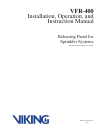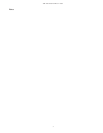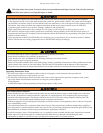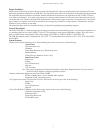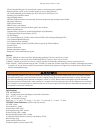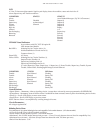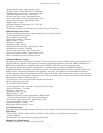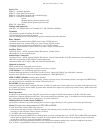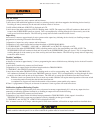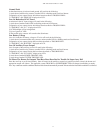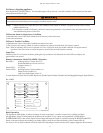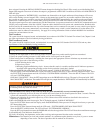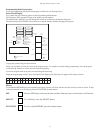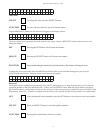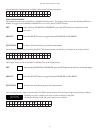5
VFR-400 • 5403548 • REV D • 10/07
Design Guidelines
People trained in the design of special hazard systems shall determine the selection and placement of the initiating devices and
notifi cation appliances connected to the VFR-400. This responsible party shall also be familiar with the premises being protected.
The equipment shall be installed in accordance with the manufacturers instructions, the applicable version of NFPA 72 and all
local codes and ordinances. For systems employing cross zoning of smoke detectors for the activation of the release circuit, this
can include but is not limited to the installation of photoelectric and ionization types of detectors on separate zones. One of each
type of detector on separate zones shall be installed in the coverage area selected for a single detector. The detectors would be
installed in close proximity to each other.
The responsible party shall also determine the theory of operation regarding the programming sequence.
General Description
The model VFR-400 is a listed and approved, microprocessor based fi re control/releasing panel. It is primarily designed for use
as a releasing panel for pre-action, Surefi re
®
, Firecycle
®
III, and deluge, water based extinguishing systems. They may also be
used as stand alone fi re control panels. These units comply with NFPA-13, NFPA-15,NFPA-72, and NFPA-750.
The VFR-400 complies with UL Standard 864, ULC S527-77, Canadian Electrical Code Part 1 C22.1, ULC S524, FM, CSFM
and NYMEA.
System Features
• Four Class B (Style B) Initiating zones. Each initiating zone can be set up for any of the following:
· Alarm Zones
· Detection alarm zone
· Waterfl ow
· Linear Heat Detection up to 700 ohms per zone.
· Manual Release
· Viking Firecycle Detectors (Zone 1 only)
· Supervisory Zones
· Supervisory
· Tamper
· Low Air Supervisory
· High Air
· Low Air Alarm
Note: Only zones programmed as Detection, Waterfl ow, Linear Heat, Manual Release, Firecycle and Low
Air Alarm can be mapped to outputs programed as release.
• Remote Annunciator Output for connection to RA-4410RC:
· RS-485 communication, (2-wire shielded cable required)
· Regulated 24VDC annunciator power
• Two Supervisory Zones, Class B (VDC Style B). These zones can be set up for any of the following:
· Supervisory
· Tamper
· Low Air Supervisory
· High Air
• Four Class B (Style Y) Output circuits. Each output can be set up for any of the following:
· Notifi cation Appliance circuit
· Releasing circuit
· Supervisory Bell circuit
· Trouble Bell circuit



